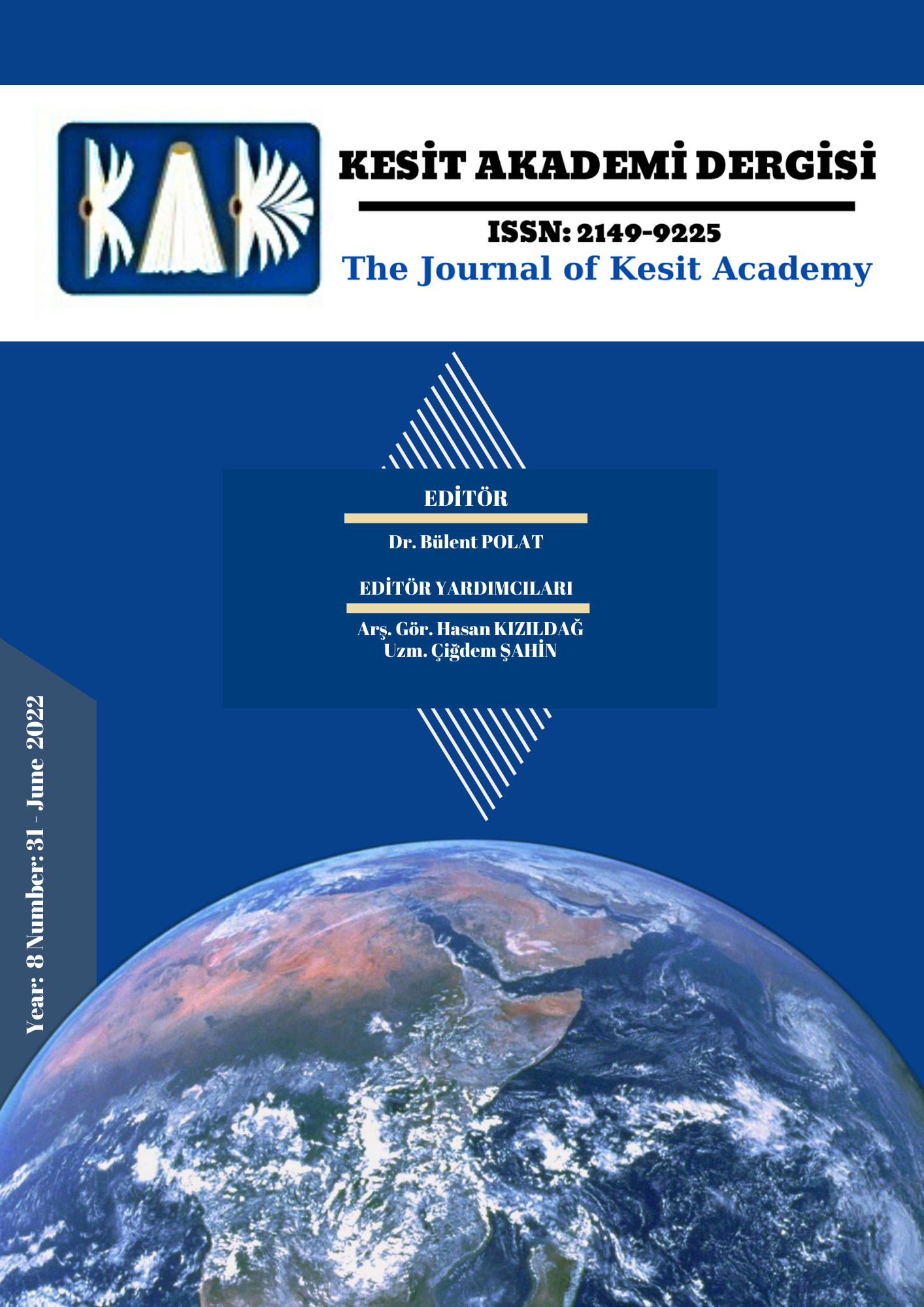Carrickmacross Dantelleri ve İğne Oyalarıyla Uygulama Örneğinde Tekstil ve Lif Sanatı Kavramlarına Bir Bakış
Author :
Abstract
Geleneksel el sanatlarının bir dalı olarak dantel, dünya üzerinde ait olduğu coğrafya ile şekillenen, kültürlerin gelenekler ile aktarımında bir araç haline gelen, özenli ve oldukça zahmetli bir el sanatıdır. Bu çalışmalar her ne kadar geleneksel olarak nitelendirilseler de yeni yaklaşımlar ile güncel yorumlar kazandırılarak farklı alanlarda örnekler sunmaktadırlar. Carrickmacross dantelleri, Avrupa dantelleri arasında yer alan, Sanayi Devrimi sonrasında makinede üretimi de sağlanmış olan bir çeşit aplike dantel olarak değerlendirilen İrlanda’ya özgü nakışlı çalışmalardır. Bu çalışma sürecinde makine üretimi sayesinde günümüz tekstil sektöründe yaygın olarak bilinen Carrickmacross danteli ile nispeten daha az tanınan Anadolu kültürünün önemli bir el sanatı olan iğne oyası tekniğiyle özgün bir uygulama gerçekleştirilmiştir. Makale çalışmasının amacı, ele alınan teknikleri asıl işlevlerinden izole ederek değerlendirmek üzere detaylı şekilde araştırıp, deneyimlemek ve gerçekleştirilen uygulama üzerinden, geleneksel tekstil tekniklerinin yorumlanması sonucu üretilen objeleri plastik ifadelerinin kategorileri açısından yoruma açmaktır. Geleneksel üretim yöntemlerinin zanaattan beslenerek, evrensel bir yaklaşımla yeniden ele alınması çalışmanın bir diğer amacıdır.
Keywords
Abstract
Lace art, which is a branch of conventional handicrafts, is a detailed and laborious handicraft that is shaped by the geography it belongs to, and has become a tool in the transfer of cultures with customs. Although these craft works have been described as conventional, they can provide examples in different fields by gaining up-to-date interpretations with new approaches. Carrickmacross laces are, as a part of Irish culture, embroidered works that are among the European laces, started to be produced by machines after the Industrial Revolution and are claimed as a kind of applique lace. In this design process, Carrickmacross lace, which is an accomplishment of machine production and is widely known in the textile industry, and needle lace technique, which is an significant handicraft of the Anatolian culture, were used together, and as a result, an unique work of art was created. The fundamental motivation behind the article is to investigate and experience the techniques in order to evaluate them by isolating them from their main functions, and to open the objects produced by the interpretation of traditional textile techniques to interpretation in terms of the categories of plastic expressions. Another purpose of the article is to feed traditional production methods from the craft and reevaluate them with a universal approach.
Keywords
- Acar, S. ve Ercivan, G.B. (2005). Efe iğne oyalarının günümüz tekstil trendlerindeki yeri. Vision in Textiles, 13. Uluslararası European Textil Network (ETN) Konferansı, İzmir: Dokuz Eylül Üniversitesi.
- Acar S. ve Ercivan G.B. (2006). Aydın ili ve çevresinde üretilen iğne oyaları ve günü- müzdeki durumu. Uluslararası Geleneksel Sanatlar Sempozyumu Tam Metin Kitabı, İzmir: Dokuz Eylül Üniversitesi, (ss.711-715).
- Acar, S. (2013). Tapestry geleneğinden lif sanatına geçiş sürecinde Jago Buic ve sanatsal çalışmaları. Yedi Sanat Tasarım ve Bilim Dergisi, (9), 51-59.
- Arabalı Koşar, S. T. (2017). Çağdaş sanat disiplinleri arası etkileşimlerde lif sanatı. İdil Dergisi, 6 (35), 2035-2059.
- Arslan, C. (2018). Lif sanatına kuramsal bakış. The Journal of International Lingual, Social and Educational Sciences, Volume: 4, Number: 1, 86-97.
- Atay, Ayten (1987). Örücülük. Milli Eğitim Basımevi.
- Büyüksofuoğlu, F. (2019). Tekstil sanatında zanaatin yeri [Yayınlanmamış Yüksek Lisans Tezi]. Marmara Üniversitesi Güzel Sanatlar Enstitüsü Tekstil Bölümü.
- Gümüş D. ve Uray G. (2018). Oya el sanatı üzerine bir inceleme. Uluslararası Sosyal Araştırmalar Dergisi / The Journal of International Social Research. 11 (55), 355-369.
- Kahveci, M. ve Bahşioğlu A. (2001). Türk oyaları kataloğu. Maddi kültür Dizisi, No: 21, 7. T.C. Kültür Bakanlığı Yayınları.
- Kapar, S. (2018). Çağdaş sanatta alternatif malzeme olarak tekstil ve zanaatten sanata dönüşümü. Journal Of Arts, (1) 2.
- Koplos, J. (1986). When is fiber art "Art"?, Fiberarts. Vol. March/April.
- Köklü, H., Özdemir, M., Yetim, F. (2010). Gerede iğne oyaları. Güzel Sanatlar Enstitüsü Dergisi, 0(20), 83-90.
- Levey, S. (1983). Lace – a history. V&A Museum.
- Lunin, L. F. (1990). The descriptive challenge of fiber art, Library Trends/Spring. The Board of Trustees, University of Illinois, Vol:38, No: 4.
- Nordness, L. (1970). Objects: USA. Viking Press.
- Onuk, T. (1988). İğne oyaları. Türkiye İş Bankası Kültür Yayınları.
- Onuk, T. (2000). Osmanlıdan günümüze oyalar. Kültür ve Turizm Bakanlığı Yayınları.
- Özay, S. (1995), ‚Gelenekten geçişler‛ dokumanın bugünü: lif sanatı. Milliyet Sanat Dergisi, Sayı: 358, 34-35.
- Shepherd R. (2003). Lace classification system. Powerhouse Publishing.
- Sönmez, K. (2020). Türk kültüründe Oyalar: Gaziantep ili Nizip ilçesi örnekleri. İdil, (65), 106-116.
- Taylor, D. (1983). The first through the tenth biennales znternationalesde la tapisserie. Lau- sanne, Switzerland. [Unpublished doctoral dissertation], North Texas State University.
- Tunalı İ. (1990), Felsefe. Altın Kitaplar Yayınevi.
- Türk Dil Kurumu Sözlükleri (2018). Güncel Türkçe Sözlük.
- Yıldız, G. (2019). Dantel teknikleri ve tek renkli dantel efektlerinin dijital baskı tekniği ile uy- gulanması [Yayınlanmamış Yüksek Lisans Tezi]. Dokuz Eylül Üniversitesi Güzel Sanatlar Enstitüsü Tekstil ve Moda Tasarımı Bölümü.
- URL-1: Yalçınkaya, T. (2012). Anadolu Külltu ru nde Dantel. http://turklacemuseum.blogspot.com/ 2012/02/anadolukulturunde-danteln_26.html
- URL-3: ‚[. Herczeg, The tree‛. https://www.agnesherczeg.com/2019.html
- URL-6: ‚Jordan, S. (2018). In Ireland, Making lace for the love of it, The New York Ti- mes‛. https://www.nytimes.com/2018/12/05/ fashion/lace-carrickmacrossireland.html
- URL-7: ‚Gillett, M.C. (2020). The Irish Homestead’s ‘Lace Designs’ Series (1900- 1902)‛.https://laceincontext.com/tag/carrickmacross-lace/
- URL-9: ‚O’Cléirigh, N. (1985). Carrickmacross Lace‛, http://www.thelacegallery.com/history /carrickmacross-lace/
- URL-19: ‚Leyla Demirtaş, İğne oya detaylı çalışma‛. http://muhteremlesergiye.blogspot.com /2017/11/ igne-oyasi-sergisi.html
- URL-20: ‚İğne oyası branşı çalışmaları, İSMEK Feshane Sergisi‛. http://muhteremlegeziye. blogspot.com/2011/07/2011-ismek-feshane-sergisiigne-oyasi.html?m=1





